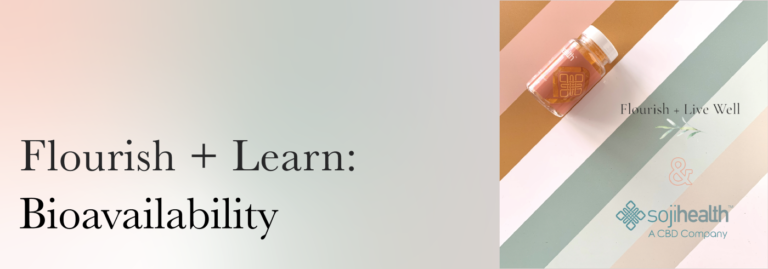We are excited to bring you our first official installment of our blog series, Flourish + Learn, in partnership with Soji Health. This series explores the science behind wellness and CBD. Through a series of monthly blog posts, we will offer scientifically backed wellness tips and lessons to help you live your best life. We will also explain important definitions, ideas, and equip you with valuable tools with which to approach the CBD and wellness industry.
For this month’s post, we are going to explore Bioavailability:
Bioavailability refers to how much, and at what rate, something gets absorbed by your bloodstream. When referring to CBD, understanding the bioavailability can help you determine how much you need to take—and in what form—to ensure a proper dose actually ends up in your system and you feel the desired effects.
To understand bioavailability within the context of hemp-based cannabinoids, it would be helpful to start with some basic science:
To begin, cannabinoids are lipophilic molecules, which means they are oil-based compounds that are not soluble in water. Further, when you place extracted hemp oils into water, they float and are unable to mix or dissolve. This is an issue because our bodies are up to 60% water, and have difficulty dissolving, and more importantly, absorbing these types of molecules.
To connect this back to bioavailability: because cannabinoids are lipophilic molecules, they are very difficult to be absorbed by the bloodstream with high bioavailability. In fact, the chances of passing 100% of any lipophilic molecule into the bloodstream by ingestion is almost 0%.
After decades of research, however, methods have been developed to allow these cannabinoids to be more readily absorbed by our water-based bodies.
One of the better methods is nano-liposomal technology. Essentially, this technology utilizes liposomes, a sort of protective bubble that encapsulates CBD molecules. Using liposomes as carriers, CBD has a nearly 5-6x higher bioavailability.
This being said, it is important to keep in mind that different delivery methods have different effectiveness:
- Inhalation: Inhaling CBD is the most effective method for ensuring a high bioavailability, as high as 40%
- Sublingually: When administered sublingually (via drops held beneath the tongue), CBD oil has a bioavailability of 13% to 19%
- Orally: Oral ingestion may be common, it’s also the least effective method for taking CBD. The oral bioavailability of CBD is between 10% to 20%
- Topically: Because the CBD only interacts with local receptors in your skin, though, it won’t enter the bloodstream, resulting in 0% bioavailability. As a result, topical administration will be ineffective for relieving conditions which require the CBD to bind to cannabinoid receptors in the brain and central nervous system, such as anxiety, epilepsy or PTSD.
To learn more about bioavailability, you can read about it on Soji Health’s website or reach out to one of our expert staff members. We hope you enjoyed this edition of Flourish + Learn and we look forward to sharing the next installment of this series next month.
